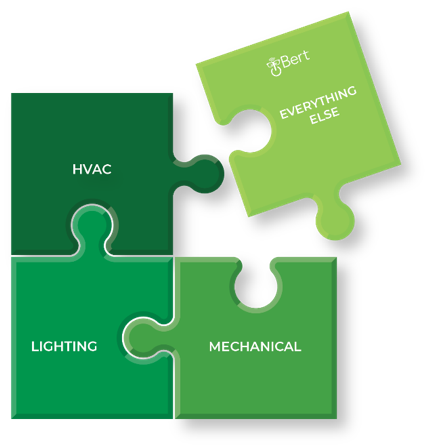Bert Plug Load Solution Delivers Missing Energy Management Piece
Welcome to Bert’s new blog about plug load solutions for commercial buildings. We plan to cover a variety of topics – potential energy savings from managing loads, various plug load control options, implementation strategies and more.
Bert’s Plug Load Solution for “Everything Else” in the Building
Bert’s plug load solution delivers the missing energy management puzzle piece; control and management for small electric loads not connected to Building Automation Systems (BAS). These loads have many names: plug loads, hardwired loads, commercial miscellaneous electric loads, plug and process loads (PPLs). While individual loads are small, plug loads are actually the fastest growing source of energy usage in commercial buildings. In addition, plug loads are also frequently the largest source of energy usage.
The BAS handles HVAC, lighting and mechanical systems, but doesn’t address plug loads. Bert describes these loads – which are outside of a building’s core functions – as “everything else” in commercial buildings. Typical devices include printers, copiers, classroom electronics, vending machines, exhaust fans, break room equipment, window AC units, electric hot water heaters and air handling units.
Plug loads run 24/7 because they are not managed or controlled. Buildings waste money powering devices in empty buildings. Bert’s plug load management solution uses the existing wireless network to turn devices off when buildings are empty. At the same time, Bert collects and stores real-time granular device, measurement and temperature data for increased efficiency and comfort. As a result, building operators save money and gain valuable insight into building operations. Bert can either be installed as a standalone solution or integrated into the existing BAS.

Plug Load Data from 40,000 Loads
Bert is the leading wireless Plug Load Solution supplier, with over 40,000 smart plugs and inline units installed. Bert controls devices in school districts, colleges, local governments, office buildings, and sporting venues. In each project, Bert inventories the number and types of plug and hardwired loads by building. Data is entered into Bert’s proprietary data model.
In short, we crunch the numbers to calculate the average number of devices – printers, vending machines, charging carts etc. – found per square foot in particular building types. Bert maintains density factors for elementary schools, middle schools, high schools, college academic buildings, academic labs, administrative/office buildings and public assembly buildings.
Bert collects baseline measurement data from loads each device after the plug load control hardware is installed. The data is analyzed to determine average standby loads and energy usage patterns for various devices.
How Much Energy Do Plug Loads Use Each Year?
To put plug loads into context:
According to the Department of Energy, devices with non-traditional end uses consumed over 7 quadrillion BTU in 2012. That’s a big number. In fact, it’s equivalent to the amount of dynamite needed to carve Mount Rushmore 135,800,000 times, according to the Department of Energy’s Direct Currents Energy Unit Calculator . The calculator uses alternative energy units to make energy consumption easier to understand.
The Energy Information Administration Annual Energy Outlook (AEO) 2015 forecasts that primary energy consumption from plug loads will grow 27% from 2016 to 2030 and the contribution of these loads to total building energy consumption increases from 36% in 2016, to 43% in 2030 under its business-as-usual scenario.
Standby or overnight loads associated with MELs account for more than 100 billion kWh and $ 11 billion in annual energy costs in the United States alone, according to Energy Star®. In case you’re wondering – that’s the same amount of energy needed for 6,116 Moon Landings.

